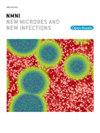Taenia asiatica: Mitochondrial signatures based analysis of an emerging public health threat in India
IF 5.4
Q2 INFECTIOUS DISEASES
引用次数: 0
Abstract
Background
Taenia asiatica is a zoonotic tapeworm, commonly known as Asian Taenia. It is an emerging sister species of T. saginata with pigs as intermediate hosts. The present study aimed at genetic characterization and population structure analysis of T. asiatica metacestodes in slaughtered pigs in Haryana, north India.
Methods
In total, the vital organs of 253 slaughtered pigs were screened for the presence of T. asiatica metacestodes. The molecular identification and phylogenetics were performed targeting the mitochondrial NADH dehydrogenase subunit 1 (nad1) and cytochrome C oxidase subunit 1 (cox1) genes. The median-joining haplotype network and population structure analyses were performed with the sequences generated herein and GenBank-archived T. asiatica sequences for both mitochondrial signatures.
Results
Out of 253 pigs screened, the liver of only one animal showed the presence of T. asiatica metacestodes. The sequences generated herein exhibited 99.60 % and 98.85 % similarity to the GenBank-archived sequences of T. asiatica corresponding to the nad1 and cox1 genes, respectively. Overall, 2 and 6 haplotypes for the overall data set with low nucleotide (0.00399 ± 0.00237 and 0.00095 ± 0.00042) and low haplotype (0.400 ± 0.237 and 0.131 ± 0.054) diversities were recorded for the nad1 and cox1 genes, respectively. The negative values recorded for the neutrality indices exhibited deviations from neutrality and hence, propounded recent population expansion or purifying selection or selective sweep.
Conclusions
The findings of the present study are of significant medical importance considering an emerging global public health threat of the neglected tapeworm T. asiatica.
亚洲带绦虫:基于线粒体特征分析的印度新出现的公共卫生威胁。
背景:亚洲带绦虫是一种人畜共患绦虫,俗称亚洲带绦虫。它是以猪为中间宿主的一种新出现的姐妹种。本研究旨在对印度北部哈里亚纳邦屠宰生猪中亚洲散斑绦虫的遗传特征和种群结构进行分析。方法:对253头屠宰猪的重要脏器进行筛选,检测有无亚洲散斑绦虫。针对线粒体NADH脱氢酶亚基1 (nad1)和细胞色素C氧化酶亚基1 (cox1)基因进行分子鉴定和系统发育。利用本文生成的序列和genbank存档的亚洲弓形虫线粒体特征序列进行中位连接单倍型网络和种群结构分析。结果:筛选的253头猪中,只有1头猪的肝脏中存在亚洲散囊绦虫。所得序列与genbank存档的亚洲田鼠nad1和cox1基因序列的相似性分别为99.60%和98.85%。总体而言,nad1和cox1基因的低核苷酸(0.00399±0.00237和0.00095±0.00042)和低单倍型(0.400±0.237和0.131±0.054)多样性分别为2个和6个。中性指数的负值显示出与中性的偏差,因此,提出了最近的种群扩张或净化选择或选择性清除。结论:考虑到被忽视的绦虫亚洲绦虫对全球公共卫生的威胁,本研究的发现具有重要的医学意义。
本文章由计算机程序翻译,如有差异,请以英文原文为准。
求助全文
约1分钟内获得全文
求助全文
来源期刊

New Microbes and New Infections
Medicine-Infectious Diseases
CiteScore
10.00
自引率
2.50%
发文量
91
审稿时长
114 days
 求助内容:
求助内容: 应助结果提醒方式:
应助结果提醒方式:


